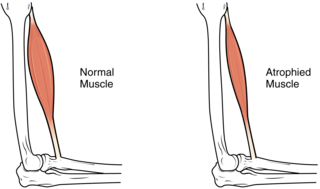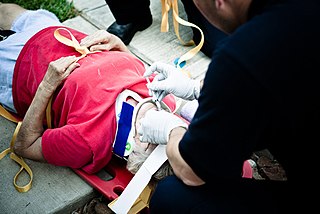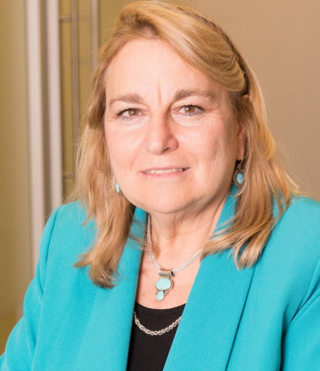Related Research Articles

Brown adipose tissue (BAT) or brown fat makes up the adipose organ together with white adipose tissue. Brown adipose tissue is found in almost all mammals.

Geriatrics, or geriatric medicine, is a medical specialty focused on providing care for the unique health needs of the elderly. The term geriatrics originates from the Greek γέρων geron meaning "old man", and ιατρός iatros meaning "healer". It aims to promote health by preventing, diagnosing and treating disease in older adults. There is no defined age at which patients may be under the care of a geriatrician, or geriatric physician, a physician who specializes in the care of older people. Rather, this decision is guided by individual patient need and the caregiving structures available to them. This care may benefit those who are managing multiple chronic conditions or experiencing significant age-related complications that threaten quality of daily life. Geriatric care may be indicated if caregiving responsibilities become increasingly stressful or medically complex for family and caregivers to manage independently.
Calorie restriction is a dietary regimen that reduces the energy intake from foods and beverages without incurring malnutrition. The possible effect of calorie restriction on body weight management, longevity, and aging-associated diseases has been an active area of research.

Sarcopenia is a type of muscle loss that occurs with aging and/or immobility. It is characterized by the degenerative loss of skeletal muscle mass, quality, and strength. The rate of muscle loss is dependent on exercise level, co-morbidities, nutrition and other factors. The muscle loss is related to changes in muscle synthesis signalling pathways. It is distinct from cachexia, in which muscle is degraded through cytokine-mediated degradation, although both conditions may co-exist. Sarcopenia is considered a component of frailty syndrome. Sarcopenia can lead to reduced quality of life, falls, fracture, and disability.
Multimorbidity, also known as multiple long-term conditions (MLTC), means living with two or more chronic illnesses. For example, a person could have diabetes, heart disease and depression at the same time. Multimorbidity can have a significant impact on people's health and wellbeing. It also poses a complex challenge to healthcare systems which are traditionally focused on individual diseases. Multiple long-term conditions can affect people of any age, but they are more common in older age, affecting more than half of people over 65 years old.

Ignatz Leo Nascher an Austrian-American medical doctor and gerontologist. He coined the term "geriatrics" in 1909. Born in Vienna, Nascher immigrated to the United States at a young age. His ideas on geriatrics, initially published in the New York Medical Journal, helped lay the groundwork for the modern study of ageing and elder care. He was the first president of the American Geriatrics Society, and died in 1944. Gerontologist A.M. Clarfield wrote in 1990 that Nascher was "a pioneer and a prophet, a man clearly ahead of his time."

Frailty is a common geriatric syndrome that embodies an elevated risk of catastrophic declines in health and function among older adults. Frailty is a condition associated with ageing, and it has been recognized for centuries. It is a marker of a more widespread syndrome of frailty, with associated weakness, slowing, decreased energy, lower activity, and, when severe, unintended weight loss. As a frequent clinical syndrome in the elderly, various health risks are linked to health deterioration and frailty in older age, such as falls, disability, hospitalization, and mortality. Generally, frailty refers to older adults who lose independence. It also links to the experiences of losing dignity due to social and emotional isolation risk. Frailty has been identified as a risk factor for the development of dementia.
The compression of morbidity in public health is a hypothesis put forth by James Fries, professor of medicine at Stanford University School of Medicine. The hypothesis was supported by a 1998 study of 1700 University of Pennsylvania alumni over a period of 20 years.
George M. Martin was an American biogerontologist. He was a faculty member at the University of Washington from 1957 until the end of his career. Martin was a professor emeritus in the Department of Pathology, adjunct professor of genome sciences, and director emeritus of the University of Washington's Alzheimer's Disease Research Center.
Becca R. Levy is a professor of Epidemiology at Yale School of Public Health and Professor of Psychology at Yale University. She is a leading researcher in the fields of social gerontology and psychology of aging. She is credited with creating the field of how age stereotypes, which are assimilated from the culture, impact the health of older individuals. The Dean of Columbia School of Public Health describes Levy as "a pioneer" in the "growing body of impressive research showing that our attitudes toward aging affect our health, our resilience in the face of adversity, and our very survival."

Geriatric trauma refers to a traumatic injury that occurs to an elderly person. People around the world are living longer than ever. In developed and underdeveloped countries, the pace of population aging is increasing. By 2050, the world's population aged 60 years and older is expected to total 2 billion, up from 900 million in 2015. While this trend presents opportunities for productivity and additional experiences, it also comes with its own set of challenges for health systems. More so than ever, elderly populations are presenting to the Emergency Department following traumatic injury. In addition, given advances in the management of chronic illnesses, more elderly adults are living active lifestyles and are at risk of traumatic injury. In the United States, this population accounts for 14% of all traumatic injuries, of which a majority are just mainly from falls.
A geroprotector is a senotherapeutic that aims to affect the root cause of aging and age-related diseases, and thus prolong the life span of animals. Some possible geroprotectors include melatonin, carnosine, metformin, rapamycin, nicotinamide mononucleotide (NMN) and delta sleep-inducing peptide.

Linda P. Fried is an American geriatrician and epidemiologist, who is also the first female Dean of Columbia University's Mailman School of Public Health. Her research career is focused on frailty, healthy aging, and how society can successfully transition to benefit from an aging population.

Rochelle (Shelley) Buffenstein is an American comparative biologist currently working as Research Professor at the University of Illinois Chicago. Previously, she was a senior principal investigator at Calico Life Sciences, an Alphabet, Inc. funded research and development company investigating the biology that controls aging and lifespan where she used the extraordinarily long-lived cancer resistant naked mole-rat as an attractive counter-example to the inevitability of mammalian aging; for at ages greatly exceeding the expected maximum longevity for this mouse-sized rodent, they fail to exhibit meaningful changes in age-related risk of dying or physiological decline. As such these rodents likely provide the blueprint for how to stave off myriad adverse effects of aging and provide proof of concept that age-related health decline can be avoided in humans.
Rozalyn (Roz) Anderson is a professor at the University of Wisconsin School of Medicine and Public Health. She studies aging and caloric restriction in primates.
Age-related mobility disability is a self-reported inability to walk due to impairments, limited mobility, dexterity or stamina. It has been found mostly in older adults with decreased strength in lower extremities.
Jiska Cohen-Mansfield is the Igor Orenstein Chair for the Study of Geriatrics at Tel Aviv University Medical School and a professor at the Department of Health Promotion at the School of Public Health in the Sackler Medical Faculty at Tel Aviv University. She is the director of the Minerva Center for Interdisciplinary Study of End of Life at Tel-Aviv University.
Dynapenia is the loss of muscular strength not caused by neurological or muscular disease that typically is associated with older adults.

Kathleen Ries Merikangas is the Chief of the Genetic Epidemiology Research Branch in the Intramural Research Program at the National Institute of Mental Health (NIMH) and an adjunct professor of epidemiology at the Johns Hopkins Bloomberg School of Public Health. She has published more than 300 papers, and is best known for her work in adolescent mental disorders.
The Thai frailty index is the index commonly used to measure frailty in Thailand. It consists of 30 variables, including hypertension; diabetes; stroke; chronic obstructive pulmonary disease; chronic kidney disease, cognitive impairment; falls; dental problems; hearing problems; underweight; urinary or fecal incontinence; poor quality of life; depressed mood; fatigue; sleep problems, needing help for bathing; dressing, eating; walking; toileting; drug management; and doing housework. The index ranges from 0 to 30, 30 being the highest level of frailty. The index can be used to predict all-cause mortality.
References
- 1 2 3 Wereschagin, Mike (2 June 2014). "Newsmaker: Dr. Anne B. Newman". Trib Total News Live. Trib Total Media, LLC. Retrieved 12 November 2016.
- 1 2 3 4 "Anne B. Newman, MD, MPH". Pitt Public Health. University of Pittsburgh Graduate School of Public Health. Retrieved 12 November 2016.
- 1 2 "Newman, Anne-ResearcherID: C-6408-2013". Thomson Reuters. Retrieved 4 November 2015.
- ↑ Newman, Anne B.; et al. (29 July 2009). "Total and Cause-Specific Mortality in the Cardiovascular Health Study". The Journals of Gerontology: Series A. 64A (12): 1251–1261. doi:10.1093/gerona/glp127. PMC 2773812 . PMID 19723772.
- ↑ Rubin, Rita (10 August 2005). "Study finds some benefits to lower-body fat". USA Today. Retrieved 4 November 2015.
- 1 2 "Einstein/Montefiore Department of Medicine". New York City, New York: Albert Einstein College of Medicine. 3 April 2014. Archived from the original on 4 March 2016. Retrieved 4 November 2015.
- ↑ "Six Women in New Teaching Posts at Leading Universities". Bartonsville, Pennsylvania: Women In Academia Report. 6 June 2014. Retrieved 4 November 2015.
- ↑ Wereschagin, Mike (2 June 2014). "Newsmaker: Dr. Anne B. Newman". Pittsburgh, Pennsylvania: Tribune-Review. Retrieved 4 November 2015.
- ↑ "Anne B. Newman citation rankings". Exaly. Retrieved 2022-06-06.